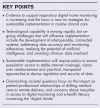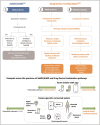Implementation of digital home monitoring and management of respiratory disease
- PMID: 37132298
- PMCID: PMC10241431
- DOI: 10.1097/MCP.0000000000000965
Implementation of digital home monitoring and management of respiratory disease
Abstract
Purpose of review: Digital respiratory monitoring interventions (e.g. smart inhalers and digital spirometers) can improve clinical outcomes and/or organizational efficiency, and the focus is shifting to sustainable implementation as an approach to delivering respiratory care. This review considers key aspects of the technology infrastructure, discusses the regulatory, financial and policy context that influence implementation, and highlights the over-arching societal themes of equity, trust and communication.
Recent findings: Technological requirements include developing interoperable and connected systems; establishing stable, wide internet coverage; addressing data accuracy and monitoring adherence; realising the potential of artificial intelligence; and avoiding clinician data overload. Policy challenges include concerns about quality assurance and increasingly complex regulatory systems. Financial barriers include lack of clarity over cost-effectiveness, budget impact and reimbursement. Societal concerns focus on the potential to increase inequities because of poor e-health literacy, deprivation or lack of available infrastructure, the need to understand the implications for patient/professional interactions of shifting care to remote delivery and ensuring confidentiality of personal data.
Summary: Understanding and addressing the implementation challenges posed by gaps in policy, regulatory, financial, and technical infrastructure is essential to support delivery of equitable respiratory care that is acceptable to patients and professionals.
Copyright © 2023 The Author(s). Published by Wolters Kluwer Health, Inc.
Conflict of interest statement
Figures



Similar articles
-
How to Implement Digital Clinical Consultations in UK Maternity Care: the ARM@DA Realist Review.Health Soc Care Deliv Res. 2025 May;13(22):1-77. doi: 10.3310/WQFV7425. Health Soc Care Deliv Res. 2025. PMID: 40417997 Review.
-
Accreditation through the eyes of nurse managers: an infinite staircase or a phenomenon that evaporates like water.J Health Organ Manag. 2025 Jun 30. doi: 10.1108/JHOM-01-2025-0029. Online ahead of print. J Health Organ Manag. 2025. PMID: 40574247
-
Patient-doctor communication.Med Clin North Am. 2003 Sep;87(5):1115-45. doi: 10.1016/s0025-7125(03)00066-x. Med Clin North Am. 2003. PMID: 14621334
-
Computer and mobile technology interventions for self-management in chronic obstructive pulmonary disease.Cochrane Database Syst Rev. 2017 May 23;5(5):CD011425. doi: 10.1002/14651858.CD011425.pub2. Cochrane Database Syst Rev. 2017. PMID: 28535331 Free PMC article.
-
Perspectives of Health Care Professionals on the Use of AI to Support Clinical Decision-Making in the Management of Multiple Long-Term Conditions: Interview Study.J Med Internet Res. 2025 Jul 4;27:e71980. doi: 10.2196/71980. J Med Internet Res. 2025. PMID: 40613609 Free PMC article.
Cited by
-
Digital markers of asthma exacerbations: a systematic review.ERJ Open Res. 2024 Dec 16;10(6):00014-2024. doi: 10.1183/23120541.00014-2024. eCollection 2024 Nov. ERJ Open Res. 2024. PMID: 39687395 Free PMC article. Review.
-
Knowledge-Behavior Relationships and Technology Adoption Among Patients With Diabetes: A Mixed-Methods Analysis of Smart Foot Care Technology.J Foot Ankle Res. 2025 Jun;18(2):e70051. doi: 10.1002/jfa2.70051. J Foot Ankle Res. 2025. PMID: 40347486 Free PMC article.
-
Perceptions Toward Using Artificial Intelligence and Technology for Asthma Attack Risk Prediction: Qualitative Exploration of Māori Views.JMIR Form Res. 2024 Oct 30;8:e59811. doi: 10.2196/59811. JMIR Form Res. 2024. PMID: 39475765 Free PMC article.
-
Implementing digital respiratory technologies for people with respiratory conditions: A protocol for a scoping review.PLoS One. 2024 Dec 27;19(12):e0314914. doi: 10.1371/journal.pone.0314914. eCollection 2024. PLoS One. 2024. PMID: 39729438 Free PMC article.
-
Digital technologies in bronchiectasis physiotherapy services: a survey of patients and physiotherapists in a UK centre.ERJ Open Res. 2024 Oct 6;10(3):00013-2024. doi: 10.1183/23120541.00013-2024. eCollection 2024 May. ERJ Open Res. 2024. PMID: 39371298 Free PMC article.
References
-
- World Health Organization. Global diffusion of eHealth: making universal health coverage achievable. Report of the third global survey on eHealth. 2019. Available at: https://www.who.int/publications/i/item/9789241511780. [Accessed 15 January 2023]
-
- World Health Organization. Report on the WHO Symposium on the future of Digital Health Systems in the European Region. Available at: https://apps.who.int/iris/bitstream/handle/10665/329032/9789289059992-en.... [Accessed 15 January 2023]
-
- Aceto G, Persico V, Pescapé A. The role of information and communication technologies in healthcare: taxonomies, perspectives, and challenges. J Netw Comput Appl 2018; 107:125–154.
-
- World Health Organization. The impact of the COVID-19 pandemic on noncommunicable disease resources and services: results of a rapid assessment. 2020. Available at: https://www.who.int/publications/i/item/9789240010291. [Accessed 15 January 2023]
Publication types
MeSH terms
LinkOut - more resources
Full Text Sources
Research Materials

